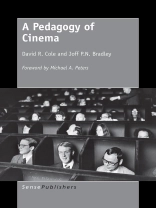A Pedagogy of Cinema is the first book to apply Deleuze’s concept of cinema to the pedagogic context. Cinema is opened up by this action from the straightforward educative analysis of film, to the systematic unfolding of image. A Pedagogy of Cinema explores what it means to engender cinema-thinking from image. This book does not overlay images from films with an educational approach to them, but looks to the images themselves to produce philosophy. This approach to utilising image in education is wholly new, and has the potential to transform classroom practice with respect to teaching and learning about cinema. The authors have carefully chosen specific examples of images to illustrate such transformational processes, and have fitted them into in depth analysis that is derived from the images. The result is a combination of image and text that advances the field of cinema study for and in education with a philosophical intent.
“This outstanding new book asks a vital question for our time. How can we educate effectively in a digitalized, corporatized, Orwellian-surveillance-controlled, globalized world This question is equally a challenge asked of our ability to think outside of the limiting parameters of the control society, and the forces which daily propel us ever-quicker towards worldwide homogenization. With great lucidity, Cole and Bradley offer us profound hope in Gilles Deleuze’s increasingly popular notion of ‘cine-thinking’. They explore and explain the potential that this sophisticated idea holds for learning, in an easy going and accessible way, and with a range of fantastic films: from ‘Suspiria’ and ‘Performance’ through to ‘Under the Skin’ and ‘Snowpiercer’. This extremely engaging and compelling text is likely to enliven scholars and students everywhere.” – David Martin-Jones, Film and Television Studies, University of Glasgow, UK
Содержание
Foreword: A Pedagogy of Perception.- Acknowledgements.- List of Illustrations.- Introduction to ‘A Pedagogy of Cinema’.- Introduction.- Why Deleuze.- ‘A Pedagogy of Cinema’: Beyond ‘1, 2, 3’ Cinemas.- Cinema-Thinking, ‘A Pedagogy of Cinema’ and Education.- Chapters of the Book.- The Fundamentals of Horror and Learning.- Introduction.- ‘Suspiria’ – The Logic of Entrapment.- Cronenberg – What Can a Body Do.- What Is ‘Under the Skin’.- Conclusion.- Decoding through Cinema: The Case of Arthur Lipsett.- Introduction.- Part 1.- ‘21–87’.- Force Field.- Youth and the Pedagogy of Cinema.- Collage as a Scrambling of Codes (Decoding).- Bw O.- Lipsett, Time and Utopia.- Les Puissances Du Faux.- Part 2.- Breakdown.- Celebration of Man Who Builds ‘Controlled Hysteria out of Abstract Images’.- Conclusion.- Bohemianism and Pedagogy [in and out] of the Cinema.- Introduction.- What Can We Do with an East End Gangster The Teaching and Learning of ‘Performance’.- Towards a Fabulation in/of Image: Greenaway and the Invention of New Cinema.- God is Dead: The Image Has Killed Him … Russell and ‘The Devils’.- Conclusion.- Semio-Materialism and the Master of Relations.- A 1, 2.- A 1, 2, 3, 4: Peirce’s ‘Thirdness’ and Zeroness.- H2O.- Conclusion.- Congruent Theories of Time, Image and Education.- Introduction.- ‘Brazil’: One Step Forward, Two Steps Back to the Image of the Future.- Thinking Time with Memory: Multiple Ways to Distort the Passage of Time (‘Memento’).- Flight through a Frozen Landscape: ‘Snowpiercer’ and Revolution.- The Image of Impending Collision: ‘Melancholia’ and the End of the World.- Conclusion.- The Cinema of a ‘New Real’: Learning from within Images.- Introduction.- The Crisis of Mental Images.- The Light of Logos.- From Any-Space-Whatevers to Any-Warzones-Whatever.- Virilio and Cinema.- The Promise of Pharmacological Cinema.- Super-8.- Lazzarato and Video Philosophy.- Cave Philosophy and the Troglodyte within.- Conclusion.- Conclusion to ‘A Pedagogy of Cinema’.- Introduction.- Non-Place and Any-Space-Whatever.- The Chapters of This Book and the Value of ‘a Pedagogy of Cinema’.- Conclusion.- Index.












